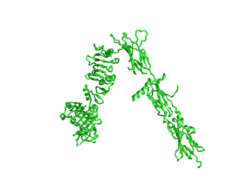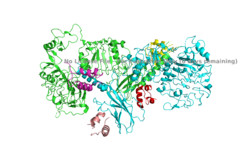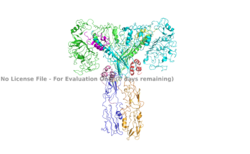Sandbox Reserved 1627
From Proteopedia
(Difference between revisions)
| Line 1: | Line 1: | ||
==''Homo sapiens'' Insulin Receptor== | ==''Homo sapiens'' Insulin Receptor== | ||
| - | <StructureSection load='6SOF' size='350' frame='true' side='right' caption='An interactive view of the human Insulin Receptor with highlighted alpha subunits, beta subunits, and binding sites. This protein becomes activated to undergo a conformation change by binding to an Insulin ligand.( | + | <StructureSection load='6SOF' size='350' frame='true' side='right' caption='An interactive view of the human Insulin Receptor with highlighted alpha subunits, beta subunits, and binding sites. This protein becomes activated to undergo a conformation change by binding to an Insulin ligand. ([https://www.rcsb.org/structure/6sof/ PDB: 6SOF]).' scene='83/832953/Active_insulin_receptor/4'> |
==Introduction== | ==Introduction== | ||
| Line 27: | Line 27: | ||
The insulin receptor can maximally bind four insulins to the active T-state at the four distinct insulin binding sites. Once insulin binds, the structural change from inactive to active state is stabilized by a tripartite interaction between insulin, L1, the C-terminal alpha helix, and the FNIII-1 domain. Studies have found that optimal insulin receptor activation requires the binding of multiple insulin ligands to two insulin binding sites. In (Figure 3) these two binding sites are colored in magenta and red. Binding of at least one insulin to the red binding site in (Figure 3) is required for the activation of the insulin receptor and the change in conformation to the active T state. <ref> DOI 10.7554/eLife.48630 </ref>. | The insulin receptor can maximally bind four insulins to the active T-state at the four distinct insulin binding sites. Once insulin binds, the structural change from inactive to active state is stabilized by a tripartite interaction between insulin, L1, the C-terminal alpha helix, and the FNIII-1 domain. Studies have found that optimal insulin receptor activation requires the binding of multiple insulin ligands to two insulin binding sites. In (Figure 3) these two binding sites are colored in magenta and red. Binding of at least one insulin to the red binding site in (Figure 3) is required for the activation of the insulin receptor and the change in conformation to the active T state. <ref> DOI 10.7554/eLife.48630 </ref>. | ||
| - | <scene name='83/832953/Inactive_insulin_receptor/1' | + | <scene name='83/832953/Inactive_insulin_receptor/1'> |
Revision as of 16:20, 5 April 2020
Homo sapiens Insulin Receptor
| |||||||||||
References
- ↑ 1.0 1.1 Tatulian SA. Structural Dynamics of Insulin Receptor and Transmembrane Signaling. Biochemistry. 2015 Sep 15;54(36):5523-32. doi: 10.1021/acs.biochem.5b00805. Epub , 2015 Sep 3. PMID:26322622 doi:http://dx.doi.org/10.1021/acs.biochem.5b00805
- ↑ Weis F, Menting JG, Margetts MB, Chan SJ, Xu Y, Tennagels N, Wohlfart P, Langer T, Muller CW, Dreyer MK, Lawrence MC. The signalling conformation of the insulin receptor ectodomain. Nat Commun. 2018 Oct 24;9(1):4420. doi: 10.1038/s41467-018-06826-6. PMID:30356040 doi:http://dx.doi.org/10.1038/s41467-018-06826-6
- ↑ Uchikawa E, Choi E, Shang G, Yu H, Bai XC. Activation mechanism of the insulin receptor revealed by cryo-EM structure of the fully liganded receptor-ligand complex. Elife. 2019 Aug 22;8. pii: 48630. doi: 10.7554/eLife.48630. PMID:31436533 doi:http://dx.doi.org/10.7554/eLife.48630
Student Contributors
- Harrison Smith
- Alyssa Ritter



